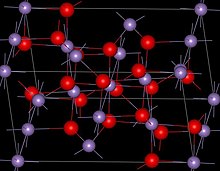Hausmannite
| Hausmannite | |
|---|---|
 Hausmannite sample from the collection of the National Museum, Prague, Czech Republic | |
| General | |
| Category | Oxide mineral |
| Formula (repeating unit) | Mn2+Mn3+2O4 |
| Strunz classification | 04.BB.10 |
| Crystal system | Tetragonal |
| Space group | Tetragonal - ditetragonal dipyramidal H-M symbol: (4/m 2/m 2/m) Space group: I 41/amd |
| Unit cell | a = 5.76 Å, c = 9.46 Å; Z=4 |
| Identification | |
| Formula mass | 228.81 |
| Color | Brownish black, grayish. |
| Crystal habit | Massive - granular - common texture observed in granite and other igneous rock. pseudo octahedral - crystals show an octahedral outline. |
| Twinning | Repeated twins on {112} |
| Cleavage | [001] Perfect |
| Fracture | Uneven - flat surfaces (not cleavage) fractured in an uneven pattern. |
| Tenacity | Brittle |
| Mohs scale hardness | 5.5 |
| Luster | Submetallic |
| Streak | Dark reddish brown |
| Diaphaneity | Opaque, transparent on thin edges |
| Specific gravity | 4.7 - 4.84, average = 4.76 |
| Optical properties | Uniaxial (-) |
| Refractive index | nε = 2.15, nω = 2.46 |
| Birefringence | δ = 0.31 |
| Other characteristics | Anisotropism: Distinct, bireflectance: weak; O = light gray; E = dark gray. |
| References | [1][2][3] |
Hausmannite is a complex oxide of manganese containing both di- and tri-valent manganese. The formula can be represented as Mn2+Mn3+2O4. It belongs to the spinel group and forms tetragonal crystals. Hausmannite is a brown to black metallic mineral with Mohs hardness of 5.5 and a specific gravity of 4.8.
The type locality is Oehrenstock (Öhrenstock), Ilmenau, Thuringian Forest, Thuringia, Germany, where it was first described in 1813.[2] Locations include Batesville, Arkansas, US; Ilfeld, Germany; Langban, Sweden; and the Ural Mountains, Russia.[1] High quality samples have been found in South Africa and Namibia where it is associated with other manganese oxides, pyrolusite and psilomelane and the iron-manganese mineral bixbyite. Wilhelm Haidinger (1827) named it in honour of Johann Friedrich Ludwig Hausmann (1782–1859), Professor of Mineralogy, University of Göttingen, Germany.[2]
References


